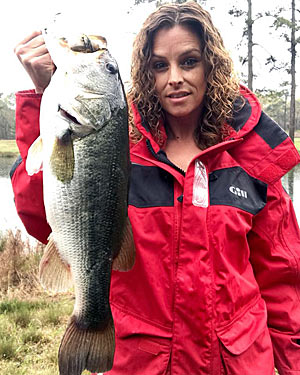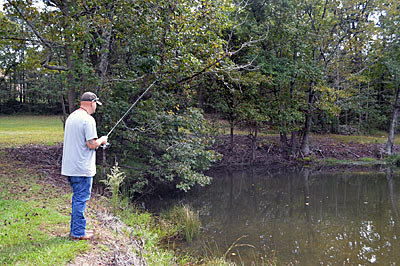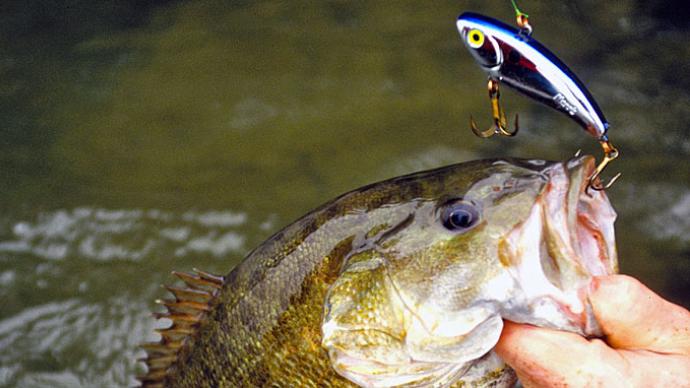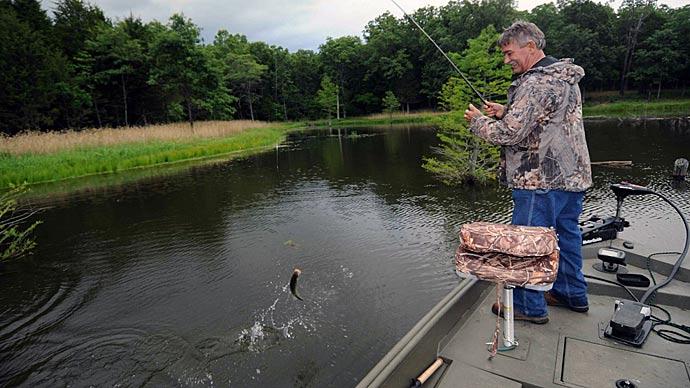
Samantha Gay recognized what she was seeing as she drove up to the pond she planned to fish that day, even though it was the first time she had seen it there. Bass were schooling, feeding on baitfish that they herded to the water’s surface. She had two soft-plastic jerkbaits rigged in tandem on one of her rods. So, she grabbed it and caught two on her first cast — her first bass fishing double. While exciting, those two firsts weren’t a total surprise. She said pond fishing is never the same two days in a row.
Ponds are a common commodity across agricultural eastern North Carolina, home for Gay, a North Carolina B.A.S.S. Nation member and adviser to local junior and high school fishing clubs. “I have about 30 [ponds] that I have permission to fish,” she said. While their sizes vary — from as small as a backyard swimming pool to large enough for a Jon boat — all have the potential to produce plenty of bass, including big ones.
Most pond fishing is done from the bank, and Gay’s trips are no exception. While ponds pose different challenges — including stepping over snakes and avoiding spooked black bears, both of which she has encountered — the objective is the same as when fishing larger natural lakes, rivers, and reservoirs from a boat. You need to find the best bass-producing spots and presentations under the current conditions. But locating them from the bank entails different attacks.
Finding structure and cover
Structure — bottom contours that attract bass — forms the foundation of all great fishing spots. And those channel ledges, drop-offs, points, flats, and other changes are made even better with the addition of cover such as aquatic vegetation, brush, laydowns, or broken rock. You have to invest time to find these spots, but the fishing rewards can be great once you do.
The ponds that Gay fishes have different maximum depths, from only a couple of feet to more than 20 feet. If she can’t see the bottom, she drags around a soft-plastic lure that’s Texas rigged or threaded on a shaky head, feeling for structure and cover. If her rod loads but still moves her lure forward, for example, she’s confident that there’s aquatic vegetation present, even if her lure doesn’t bring back a sample. Sharp taps usually indicate rock, and her lure will repeatedly hang and then go free when worked through the brush. She said it’s common for a pond owner to sink some cover, such as old Christmas trees.

Most ponds don’t keep all their structure a secret. If a stream or creek feeds it, chances are good that it’s shallow near where they enter. Start there in spring, when bass want water warmed by the sun and places to spawn. Look for a channel cut by the inflow; it can make that pond corner even better. Deep water is most often found near the dam or outflow. If there isn’t a dam, look for a standpipe that serves as a pond drain. They are placed at the deepest point to ensure the pond can be completely emptied.
If the pond’s water is clear, some of its cover should be visible from the bank. For example, several of the ponds that Gay regularly fishes are surrounded by mature trees. So, it’s easy to find and fish ones that have fallen in the water. If you’re fishing in summer, keep an eye open for emergent aquatic vegetation and submerged varieties, especially if they mat on the surface. Both are bass magnets.
Planning an approach
Half the battle is knowing what you’re fishing and where it’s found. You also need the right approach, starting with adapting to the water color. Gay said it could range from clear to muddy. Her favorite ponds are stained tannic — a color similar to iced tea — because organic material decomposes underwater.
Stained and muddy water hide approaching anglers from pond bass laying along the bank. But when clear water offers them a perfect view, Gay stands farther from the water’s edge. That lessens the chance of spooking shallow bass. She speaks from experience, having seen plenty scoot off when she wasn’t careful. And in any water color, pond bass may feel you walking to or along the shoreline, the vibrations traveling from the ground into the water. So, step slowly and only as needed.
Gay uses other clues for locating bass, including wading birds such as herons. They feed on baitfish, so you are likely to find bass where you find them. She’ll watch for these birds as she approaches a pond, first fishing the stretch or corner where they are standing.
Weather also is an excellent direction. Bass in ponds often react to weather changes faster than those in larger rivers, reservoirs, and lakes, a result of swimming in a more confined space. Joey Randall sees that when he leaves the kayak, he fishes bass tournaments from home and fishes any of several ponds around his Charlotte, N.C., home. Pond bass could start biting better when clouds cover the sun, or a slight breeze blows.

Gay always welcomes wind, preferring to cast from the windblown side, where plankton collects, starting a food chain that continues through baitfish and bass. She said rainy days are good, too. Their low-light conditions offer bass security, making them more willing to chase and strike lures.
Some pond conditions are nearly impossible to decipher. Gay said water temperature, for example, is an unknown unless you want to mess with a handheld thermometer. Sticking your hand in it won’t help. The exact water temperature can feel cool or warm depending on the air temperature. You may get a rough idea of the temperature by identifying the water’s source. Spring-fed ponds, for example, typically run cooler in summer than those that depend on surface water. So, even when the air is stifling, bass in those ponds may feel fine underwater.
Selecting lures
Bank fishing, when compared to boat fishing, changes the locational relationship between angler and bass. On a boat, anglers can easily reposition themselves to present any lure. “It’s a big difference being on the bank,” Gay said. While bank anglers don’t have that flexibility, their tackle box is still large. They need to choose lures that work more horizontally than vertically.
All varieties of soft-plastic lures, especially those Texas rigged, are perfect for fishing a pond from the bank. So are spinnerbaits and topwaters. If Gay's fishing pond has a dock, she’ll skip a jig under it. And if the bass don’t want that, she’ll continue experimenting with different lures and colors until she finds the one they want, just like a boat-bound angler would.
Gay will fish crankbaits from the bank if they dive less than 10 feet. She steers clear of any that dig deeper. Her reluctance lies in reaching their maximum depth as the bottom starts getting shallower. That leads to snags, with the lures almost always lost because of the difficulty of getting them unstuck while on the bank.
A few other techniques don’t work well from the bank. Drop shotting a finesse technique that catches its fair share of largemouth spotted and smallmouth bass, is one. While you can catch bass casting these rigs, they work best when fished vertically on the spot.
Transferring lessons
Even with the special attacks they demand, small ponds are perfect for honing skills that catch bass anywhere. It’s a point that Gay first proved while fishing a North Carolina B.A.S.S. Nation tournament on the largest lake entirely within the state.
Gay fished her first bass tournament in 2016, which became a memorable season for another reason. At a qualifying tournament on Lake Norman near Charlotte, she caught enough spotted bass to become the first female angler to make the North Carolina B.A.S.S. Nation state team, eventually competing in the 2017 Eastern Regional on Maryland’s Chesapeake Bay. She backed that up by qualifying for the state team again in 2018 — catching her first tournament limit and making her first cull along the way — on Lake Hickory.
Gay isn’t keeping all her fishing knowledge to herself. She recently started Fishers of Kids Anglers Academy, which connects young anglers with fishing events, functions, and fishing clubs at her local high and middle schools. She said time fishing at local ponds offers members of all three groups a chance to learn and share skills with their peers and places to practice them as they have for her. It’s working. Teams from the club have qualified for and fished the Junior B.A.S.S. Nation Championship in 2017 and the TBF Junior World Championship in 2018.




